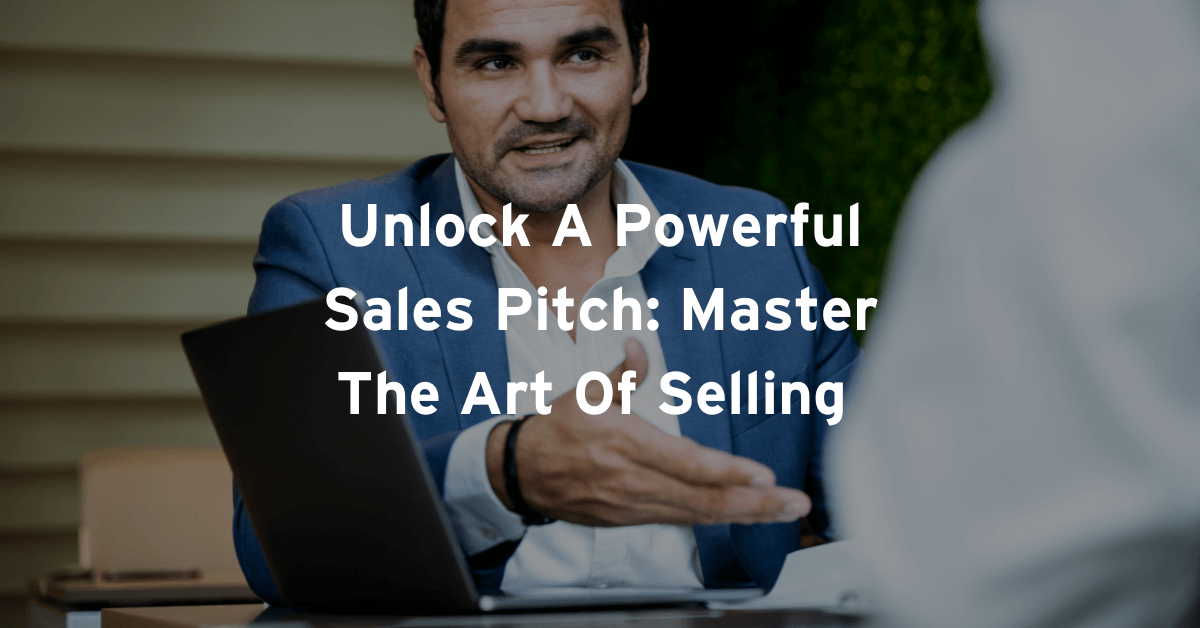The pitch is arguably the most important aspect of sales. Without a successful pitch, the sales process stops dead in its tracks. The importance of an effective sales pitch cannot be overstated.
Today, we’ll go through the pregame, pitch plan, and plenty of tips. Strap in if you’re ready to nail your sales pitch.
What is a Sales Pitch?
A sales pitch boils down to a short presentation where a salesperson explains their product or service to a potential buyer in a few minutes or less. The goal of the sales pitch is to convince the listener to do business with you. Persuasive and concise is the name of the game.

Pinpoint your WHO
The first step is knowing who you’re pitching to. Identify who they are, what they need, what they want, and what keeps them up at night. Imagine your target demographic as one person, sometimes called the “buyer persona.” Once you figure out the buyer persona, you can start cooking up a pitch that will really hit home for them.
The Layout of a Sales Pitch
The beginning of your sales pitch has to hook the buyer’s attention, while the ending has to pack the punch that will make them buy. Between the start and end, you have to hold the customer’s attention, and show them why your offer is what they’ve been looking for. Here, we’ll take a step-by-step look at the structure of an effective pitch.
Starting Your Pitch
Right out the gate, address the customer’s problem. If they don’t know the problem your product or service will be solving, they won’t be open to hearing you out. From the outset, it needs to be clear to them what they’ll lose if they don’t go with your product. Make sure the stakes come across.
Consider starting your pitch with a yes/no question that relates to the problem you’re offering to solve. For instance, if you’re selling glass cleaner, you could ask a prospective buyer, “Are you sick of seeing smudges on your windows and mirrors, even after wiping them down?” A question like this sets you up to tackle their current dissatisfactions.

Now comes the load-bearing pillar of the pitch: the value statement. Essentially, the value statement tells the buyer how you’ll solve their problem, and why your way is the best way possible. Tell the customer how they’ll benefit from your specific offer, and connect those benefits to their problems. For example: “Our glass cleaner ClearVue has been proven to remove more surface grime than any other brand out there. I personally guarantee you’ll find this to be true.”
People don’t buy because of low prices, but because of high value. If you convince them that they’re getting the most with you, they’ll be willing to pay almost any price you name. Feel free to value-stack, offering them exclusive items or other services in addition to what you’re pitching.
The Middle of Your Pitch
Stories are a key part of selling anything, period. If you really want to engage your listener, tell them a story about how the product helped you. For instance:
“I don’t know about you, but I have two little ones at home, and they like to put their hands all over our windows. Still, I care a lot about having a presentable home. I used to spend hours cleaning our windows, but I found it only took a fraction of the time with ClearVue. All my glass-related anxieties were wiped away.”

Tell your buyer a success story they’ll care about.
Nothing is more compelling than a real story, especially one that’s personal. That being said, make sure to get to the point. The last thing you want to do is ramble. Cut anything that’s not relevant to their problem and how you can solve it.
If it works into your pitch, share success stories from other sources. Pepper in testimonials, case studies, or endorsements that will convince them of the value of your product. This increases the perceived value of the product or service you’re pitching.
Emotion, Authority, and Logic
As renowned salesman and author Zig Ziglar once said, “People don’t buy for logical reasons. They buy for emotional reasons.” While a story already appeals to your buyer’s emotions, don’t be afraid to use even more empathy in your pitch. Do research beforehand if possible, or ask them to share something about their experiences. Use this information to relate to them and personalize your approach.

While emotions tend to come first, it’s still necessary to provide robust evidence and facts. A good pitch is like a good speech: it involves pathos, or emotion; ethos, or authority; and logos, or logic. For authority, provide specific examples of why your product is the best in order to cement yourself as an authority. For instance: “We’ve conducted laboratory testing that showed ClearVue removes 98% of common surface pollutants on the first pass, a figure that is at least 15% higher than any other product on the market.”
Be ready to explain any stats you tell them. Make sure that you’re familiar with all the pros of your product; your confidence and knowledge will show them that they can trust you.
Be able to reason with the information you present to them. Instead of just saying, “ClearVue is really eco-friendly, so you should buy it,” build an argument that’s compelling and airtight: “The International Green Products Council gave ClearVue a higher rating for sustainability than any other glass-cleaner brand. At half the price, going with ClearVue is a no-brainer.”
Clinching the Deal
A call to action is the moment of truth. If you’ve given the buyer the right information, plenty of value, and a sense of urgency, the close should be easy.

Tell them what will happen if they take your offer. Reiterate how much they’ll benefit, and have them imagine the alternative. For example: “Do you want to keep wasting time and money on glass cleaners that don’t work? Or are you ready to help your windows and your wallet with ClearVue today?”
Nothing makes people more confident than a guarantee. Make it clear that they have nothing to lose if they take this offer, and that you won’t leave them high and dry if they have questions or concerns.
Once you give your call to action, it’s their turn to respond. Be open to conversation. If they have concerns or objections, tell them that you completely understand, and show that you have their best interests in mind.
In the case that your listener isn’t ready to commit yet, secure a way to reach out to them in the future by getting a number or email address. Keep in touch, and remind them that you’re there if they ever need help with the problems you can solve. Keep the channel of communication open. This is also true if they buy; practicing quality customer service and creates the opportunity for repeat business.
Tips for Perfecting Your Pitch

It’s a necessity that you’re keeping your buyer engaged. Ask questions that provoke thought, provide interactive demos, offer trials – do whatever it takes to involve the buyer in your sales process. The more they’re involved, the more they’re invested.
If you know that a pitch is upcoming, be prepared with visual aids and all relevant information. Practice your pitch regularly. Be prepared to give a pitch when you don’t expect it; you never know who you’ll run into in your day-to-day life.
We know we’ve given you a lot of information here, but it’s important that you keep your pitch as brief as possible. Time is the most valuable asset, and you want to show your buyer that you respect their schedule. People will stop paying attention if your pitch doesn’t cut straight to the point.
It’s our goal to equip you with the marketing insights you need to revolutionize your sales process and take your business to the next level. We know that if you apply these pointers to your pitch script, you’ll find success in latching down new prospects, old customers, and anyone else you meet.




